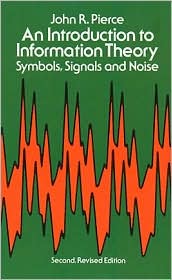Is Fitness a "Specification"? (I.D. XXII)
The question struck me as I was reading the paper which became Dembski's chapter 6, "Intelligent Design as a Theory of Information," available online here. I find this paper to be a clearer, more coherent explication of Dembski's ideas than the one in the book — though this may be because I've already read the book!
Dembski's ability to impute intelligent design turns on his definition of information that is not only highly complex, but specified:
The distinction between specified and unspecified information may now be defined as follows: the actualization of a possibility (i.e., information) is specified if independently of the possibility's actualization, the possibility is identifiable by means of a pattern.
If it is independent of the information — if it can be explained instead with reference to "background knowledge" — then the pattern qualifies as a specification, and the information (i.e., the actualization of a possibility tht reduces our uncertainty) is specified information.
Some patterns are not specifications, though. If an archer shoots an arrow into a blank wall at random and then paints a target around the arrow, the pattern that results — the target, that is — is a fabricaation, not a specification.
Sometimes, we can be sure there has been no post facto target-painting, yet the background information which undergirds the pattern we associate with some piece of information cannot be discerned at all. So the information remains unspecified, pending a requisite increase in our backgound knowledge. For example, a string of gibberish remains just that unless and until we happen to break the cryptosystem by which it was encoded.
An illuminating illustration of specification-discernment which Dembski gives in his paper (but not in the book) is that of a married couple whose six children each buy for them coordinated portions of a complete, matching set of china, on the occasion of their 50th anniversary, such that when all six gifts are put together, the whole matching set is there. The completeness of the set and the fact that all pieces match one another constitutes a pattern. The fact that "we all know about matching sets of china and how to distinguish them from unmatched sets" is the background information that makes this pattern a specification wholly independent of the actual event.
Now, what I want to know is whether fitness, in the sense spoken of by Darwinists, is a pattern which furthermore is a specification.
The "survival of the fittest" is, clearly, an event and, as such, an instance of information. It is the actualization of a possibility. According to Darwinian evolution theory, it comes about by virtue of the culling action of natural selection. Those variants within a population who chance to have mutations that help them survive, thrive, and procreate are "selected for." Those who do not are "selected against."
You might even say that there is a pattern here. Fitter variants pass their genes to the next generation with greater likelihood than less fit variants.
The question is, is this pattern one that is specified independently of the actual (survival) events themselves? Is there background information by which we can determine the pattern of events independently of the events themselves?
My inclination is to say yes.
Take, for instance, Darwin's Galapagos finches. Suppose one particular species with long bills lives by drinking nectar from long-tubed blossoms. But suppose, for independent reasons, the blossoms' tubes get still longer as the plant generations roll by, such that the finches' bills no longer reach the nectar.
We can expect the birds' bills to lengthen like Pinocchio's nose over the course of many, many finch generations. Mutations which code for longer bills will be "selected for," as the older genetic variations which used to produce shorter bills are weeded out.
So there exists a pattern: a target of increased bill length which indeed the finches hit. And I'd say this pattern is indeed a specification, since background information about the theory of natural selection specifies the pattern apart from the (survival) events themselves. That is, we can expect the bills to get longer as the blossoms do. But if the blossoms someday get shorter again, the bills will too, since making longer bills takes up more energy, energy which could be devoted instead to some other finchy function.
It would accordingly seem that Darwinian fitness is itself a target or pattern which qualifies, on the basis of independent background information — the theory of "what gets selected for and what gets selected against" — as a specification.
It might be objected that fitness is not a stationary target but a moving one. After all, finch bills need to lengthen over the course of evolutionary time under certain circumstances and are better off growing shorter under others. I don't see this as a valid objection, though: targets in shooting galleries are often moving ones, and if the shooter manages to hit them, it is even greater testimony to his skill.
Nor do I think it a valid objection to say that in real life, we are unlikely to recognize all the factors which might or might not promote a gradual change in the bill lengths of birds. I liken this situation to the cipher that hasn't been broken — which, contrary to Dembski, I would say is actually specified information, though we can't prove it. Just because we can't demonstrate specification does not mean it doesn't exist.
A more robust objection might be that blossom-length changes and bill-length changes are not independent of one another. Most evolutionary "descent with modification," culled by natural selection, involves interdependencies of "co-evolution."
I think this objection can be overcome by referencing not just the finches or the flowers alone but the entire ecosystem within which they co-evolve. Our pattern or target is accordingly that the ecosystem as a whole evolves, and does so in a way such that the "total fitness" of its denizens as a group is maximized. Our specification, though its derived pattern forms a moving, slippery, co-evolutionary target, thus remains a true function of background information — say, a theory of co-evolution — that we have developed about how this real-world fitness-maximization function can be expected to play out.
So, as a result, I'm wondering why Darwinian evolution by natural selection alone isn't itself a case of Dembskiian "complex specified information" on the march!


















0 Comments:
Post a Comment
<< Home